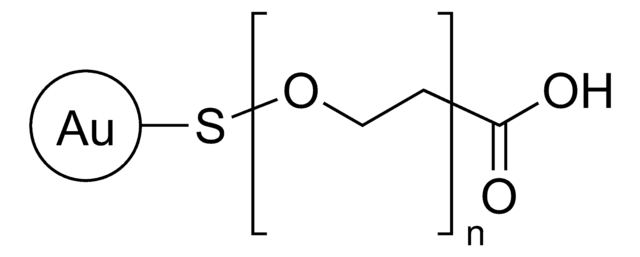765708
Gold nanoparticles
15 nm diameter, OD 50, methyl terminated, PEG 5000 coated, dispersion in H2O
Synonyme(s) :
Gold nanoparticles OMe terminated, Au NP OMe, Gold Colloid
About This Item
Produits recommandés
Matériaux
PEG 5000
Niveau de qualité
Forme
dispersion in H2O
nanoparticles
Conditionnement
poly bottle of 1 mL
DO
50
Diamètre
15 nm
pH
6.0-8.0 (25 °C)
Solubilité
water: miscible
Densité
1.00 g/cm3
λmax
520 nm
Groupe fonctionnel
methoxy
Température de stockage
2-8°C
Vous recherchez des produits similaires ? Visite Guide de comparaison des produits
Catégories apparentées
Description générale
Application
- Since they adhere to cell membranes, AuNPs may find use in cellular and intracellular targeting in targeted drug delivery applications and may also used in biodistribution studies.
- AuNPs may also be used in photothermal therapy and radiotherapy.
- AuNPs ranging from 10 to 250 nm, were studied to have been absorbed primarily by liver and spleen, when injected intravenously in rats.Whereas, 10 nm nanoparticles were distributed more broadly into various organs.
Caractéristiques et avantages
Code de la classe de stockage
12 - Non Combustible Liquids
Classe de danger pour l'eau (WGK)
WGK 1
Point d'éclair (°F)
Not applicable
Point d'éclair (°C)
Not applicable
Faites votre choix parmi les versions les plus récentes :
Déjà en possession de ce produit ?
Retrouvez la documentation relative aux produits que vous avez récemment achetés dans la Bibliothèque de documents.
Les clients ont également consulté
Articles
Biomaterials science involves the design and fabrication of smart materials for studying, directing, or mimicking biology. For successful integration of biomaterials in biological research, a meaningful understanding of biological systems is required.
Notre équipe de scientifiques dispose d'une expérience dans tous les secteurs de la recherche, notamment en sciences de la vie, science des matériaux, synthèse chimique, chromatographie, analyse et dans de nombreux autres domaines..
Contacter notre Service technique


